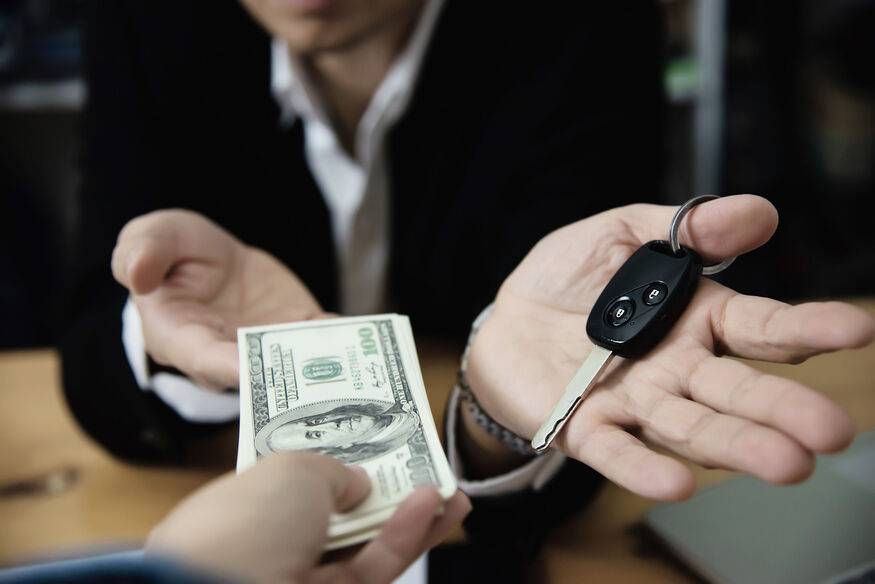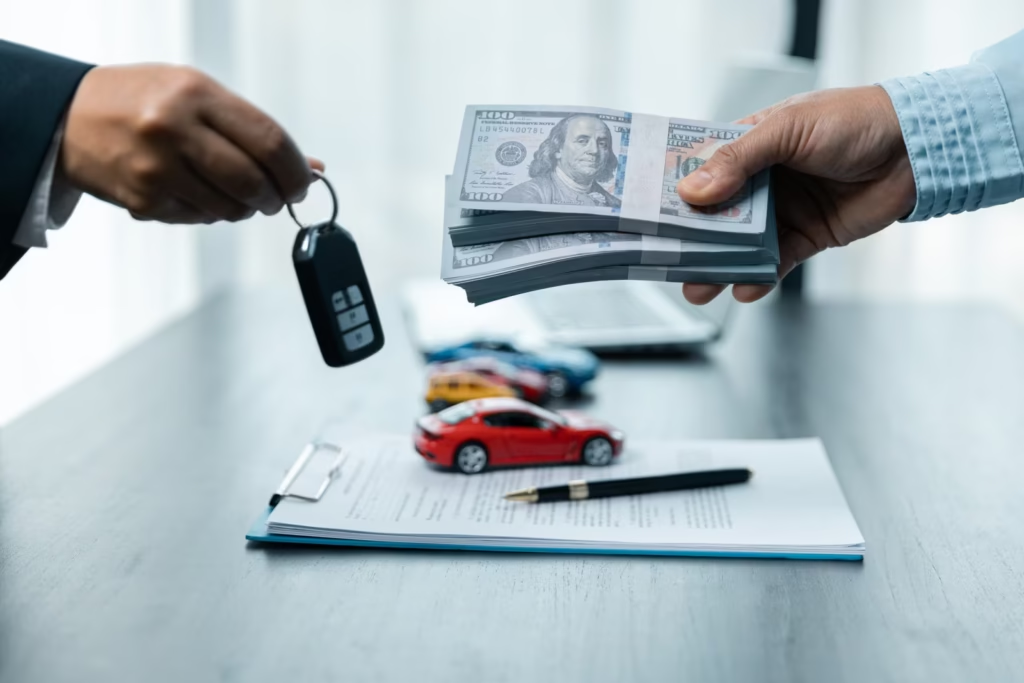What is a Car Trade-In?
So, what’s a car trade-in all about? It’s pretty simple: you hand over your current vehicle to a dealership as part of the payment for a new or used car. The dealer checks out your car, tells you its trade-in value, and knocks that amount off the purchase price of your next ride. Easy, right? Unlike selling your car privately—where you’re on your own to find a buyer, set up meetings, and handle all the paperwork—a trade-in happens right at the dealership. It’s a one-stop shop for swapping cars.
Why Do People Trade in Their Cars?
Why go this route? Convenience is the name of the game. With a car trade-in, you wrap up everything in one place—no extra trips to the Department of Motor Vehicles or awkward meetups with potential buyers. It’s a huge time-saver too. Forget spending weeks advertising your car or haggling with private parties. Plus, here’s a little teaser: in some states, trading in can even lower your sales tax bill (we’ll dig into that later!).
Let me paint a picture for you. Meet Sarah, a busy mom who was ready to ditch her old sedan for a roomy SUV. Instead of stressing over finding a private buyer, she traded in her car at the dealership. No fuss, no muss—she got a fair price and drove off in her new SUV that same day. Doesn’t that sound tempting?
Purpose of This Guide
Here’s what I’m promising you: a step-by-step rundown of the trade-in process that’s easy to follow, even if you’re a total newbie. You’ll learn how to research your car’s trade-in value, prep it like a pro, and dodge those sneaky pitfalls that could cost you cash. My goal? To help you walk into that dealership feeling confident and walk out with the best deal possible. Ready to get started? Want to know more, visit our website…
Researching Your Car’s Trade-In Value
Why Researching Your Car’s Value Matters
Picture this: you stroll into a dealership without a clue about your car’s worth. The dealer tosses out a lowball trade-in offer, and you just nod along. Yikes! That’s why researching your car’s trade-in value is a must. Knowing what your vehicle is worth gives you the upper hand when it’s time to negotiate. Without that info, dealers might undervalue your car, and you’d be none the wiser. Who wants to leave money on the table, right?
How to Determine Your Car’s Trade-In Value
So, how do you figure out what your car’s trade-in value really is? It’s not as tricky as it sounds. Here’s the breakdown:
- Online Valuation Tools
Fire up your laptop and check out tools like Kelley Blue Book (KBB), Edmunds, and NADA Guides. Just punch in your car’s make, model, year, mileage, and condition, and voilà—you’ve got an estimated trade-in value. I’d say try all three to get a range of numbers. For instance, if KBB says $9,000 and Edmunds says $8,500, you’ve got a ballpark to work with. It’s like getting a sneak peek at what the dealer might offer! - Check Local Market Listings
Want to play detective? Hop onto sites like Autotrader, Cars.com, or even Craigslist to see what similar cars are going for in your area. Look for the same make, model, year, and condition as your ride. This shows you the current market vibe and what a private buyer might pay. It’s a great way to see how your trade-in value stacks up against a private sale. - Assess Your Car’s Condition
Time to get real about your car. How’s it holding up? Here’s a quick checklist:- Mileage (lower is better—think of it like a car’s age in dog years!)
- Exterior condition (any dents, scratches, or chipped paint?)
- Interior wear (stains, tears, or that lingering fast-food smell?)
- Mechanical issues (engine hiccups, brake squeaks?)
- Recent upgrades (new tires or a fresh battery?)
If you’ve kept up with service records or made minor repairs, that could bump up your trade-in value. Dealers love a car that’s been babied.
Trade-In Value vs. Private Sale Value
Here’s a question I get a lot: Why’s my trade-in offer lower than what I could get selling it myself? Simple—dealers need to make a profit when they resell your car. Let’s say your car could fetch $10,000 from a private party. A trade-in might only net you $8,000. That $2,000 gap? It’s the dealer’s cut for handling the hassle. But for many folks, the time and stress saved make it worth it. What’s your time worth to you?
Preparing Your Car for Trade-In
Why Preparation Boosts Your Trade-In Value
Ever heard the saying, “You never get a second chance to make a first impression”? That’s spot-on for your car trade-in. A clean, well-maintained vehicle tells the dealer, “Hey, this car’s been loved!”—and that can mean a better trade-in offer. On the flip side, a messy car with food wrappers and gym bags? That’s a signal it’s been neglected, and your appraisal might take a hit. A little elbow grease can go a long way here.
Steps to Get Your Car Ready
Let’s roll up our sleeves and get your car dealership-ready. Here’s what to do:
- Cleaning and Detailing
- Exterior: Grab a bucket and sponge, and give your car a good wash and wax. A shiny outside says you’ve cared for it.
- Interior: Vacuum those seats, carpets, and floor mats like your life depends on it. Wipe down the dashboard, and kick out any trash or personal stuff. No one wants to see your old gym socks!
My take: If you’re crunched for time, a $50 pro detailing job could up your trade-in value by a couple hundred bucks. Worth it, right?
- Minor Repairs and Maintenance
- Tackle small stuff like dents, scratches, or chipped paint. These are easy fixes that dealers notice.
- Swap out burned-out bulbs or worn wiper blades—cheap and quick wins.
- Check fluids like oil, coolant, and windshield washer juice. Top ‘em off if needed.
- Got a dashboard warning light? If it’s a cheap fix, handle it. A clear dash can boost your trade-in price.
For example: Spending $75 to fix a scratch might add $200 to your offer. That’s a solid return on investment!
- Gather Documentation
- Dig up those service records to show off your car’s maintenance history. It’s like proof you’ve been a responsible owner.
- Have your vehicle title and registration handy—no delays here!
- Toss in any warranty info or manuals you’ve got. It’s a nice bonus.
Why bother? Dealers trust a car with a paper trail, and that could mean more cash in your pocket.
What to Avoid
Before you go all out, here’s a heads-up on what not to do:
- Costly Repairs: Don’t drop big money on stuff like new tires or engine overhauls. Say new tires cost $600 but only add $300 to your trade-in value—not a smart move.
- Hiding Major Issues: Thinking of glossing over accident history or a busted transmission? Bad idea. Dealers will spot it during the appraisal, and it could tank your credibility. Honesty pays off here.
The Trade-In Process at the Dealership

When you trade in your car, it all starts at the dealership. This is where they figure out your car’s trade-in value and decide how much they’re willing to offer. Let’s walk through it step by step.
What Happens During the Appraisal
Imagine pulling up to the dealership with your current vehicle. What’s the first thing they do? They check it out—big time. Here’s the scoop:
- The Inspection: The dealer will eyeball the exterior (any dings or scratches?), peek inside the interior (food wrappers or a spotless cabin?), and pop the hood to check the engine (running smooth or coughing up trouble?). They’re basically giving your car a full health checkup.
- Test Drive Time: Sometimes, they’ll take it for a quick spin to see how it drives. Does it purr like a kitten or rattle like an old tin can? This helps them gauge its performance.
- How Long It Takes: The appraisal process usually lasts 30-60 minutes. Not too shabby, huh?
- Third-Party Appraisers: Here’s a neat tidbit—some dealers bring in outside pros to do the vehicle appraisal. Why? It keeps things fair and square, so you’re not just taking their word for it.
Fun Fact: A 2023 report from Edmunds says about 35% of dealerships use third-party appraisers to set trade-in values. Pretty smart way to build trust, if you ask me!
Negotiating Your Trade-In Value
Okay, the appraisal’s done—now it’s time to talk money. Negotiating your car’s trade-in value is where you can flex a little and make sure you’re not shortchanged. Here’s how to ace it:
Preparation Tips
- Bring Your Homework: Before you go, check out sites like Kelley Blue Book or Edmunds for estimated trade-in values. Print out those numbers or snap some screenshots. It’s like having proof in your pocket!
- Show Off the Good Stuff: Does your car have low mileage? A clean vehicle title? Maybe you’ve got service records showing minor repairs like new brakes? Point these out—they can bump up your trade-in offer.
Negotiation Strategies
- Let Them Go First: Ask, “So, what’s your offer?” before you spill your research. Why give away your game plan too soon?
- Back It Up: If their offer feels low, hit them with facts. Try this: “Hmm, Kelley Blue Book says my car’s worth $9,000, but you’re offering $7,500. Can we work with that?” Evidence is your best buddy here.
- Keep Your Cool: Don’t be afraid to walk away if the deal stinks. There’s always another dealership—or even a private buyer—out there.
Dealer Tactics to Watch For
Dealers can be sneaky sometimes, so stay sharp:
- Lowball Offers: They might toss out a super-low trade-in price just to test you. Don’t bite!
- Number Mash-Up: Ever notice how they sometimes blend the trade-in value with the new car’s purchase price? It’s confusing on purpose. My tip? Negotiate the trade-in car value separately—it keeps things clear.
Timing Your Visit
Want to stack the odds in your favor? Timing matters:
- End of the Month: Dealers are hustling to meet sales goals then, so they might sweeten the deal. It’s like catching them in a good mood!
- Seasonal Trends: Got a 4WD ride? Trade it in before winter when everyone’s clamoring for one. Supply and demand, baby!
Red Flags to Watch Out For
Not every dealership plays nice. Here’s what to watch for:
- Rushed Appraisals: If they zip through the inspection in 10 minutes, raise an eyebrow. A good look takes time.
- Fuzzy Offers: If they won’t explain how they got their trade-in offer, push back. You deserve the details!
Sample Negotiation Dialogue
You: “Hey, what’s your offer for my car?”
Dealer: “We’re thinking $7,000.”
You: “Really? I checked Kelley Blue Book, and it’s closer to $9,000 with my mileage and clean title. What’s making it so low?”
Dealer: “Well, there’s some wear on the tires. How about $7,500?”
You: “I get that, but I just did the brakes, and it’s in great shape. Can you do $8,500?”
Dealer: “Let me talk to my manager… Okay, $8,000 work for you?”
You: “Sweet, let’s do it!”
See? Stay calm, use your research, and you’re golden.
Finalizing the Deal

You’ve nailed the trade-in price—high five! Now it’s time to seal the deal with some paperwork and figure out the money stuff. Let’s break it down.
Understanding the Paperwork
Paperwork might sound boring, but it’s what makes the trade-in official. Here’s what you’ll see:
- Trade-In Agreement: This spells out your car’s details and the agreed trade-in amount. It’s your proof of the deal.
- Bill of Sale: Shows how your trade-in lowers the new car’s price. Simple, but super important.
- Title Transfer: You sign over the vehicle title to the dealership. Double-check this one—it’s how ownership switches hands.
- Loan Payoff (If You’ve Got One): Still owe on your current car loan? The dealer pays off the remaining loan balance for you. Just make sure you know how it affects your new loan terms.
Pro Tip: Ask the dealer to explain each document before you sign. It’s your money—own it!
Tax Benefits of Trading In
Here’s a little bonus you might not expect: trading in can save you cash on sales tax in lots of states. How? When you trade in, they subtract your car’s trade-in value from the new car’s price before taxing it. Check this out:
- Example: New car costs $25,000, and your trade-in is worth $10,000. You only pay tax on $15,000. At a 6% sales tax rate, that’s $900 instead of $1,500 without the trade-in. Boom—$600 saved!
Heads-Up: Tax rules differ by state, so peek at your local Department of Motor Vehicles site to confirm. Wouldn’t it be awesome to pocket that extra cash?
Handling Negative Equity
Ever heard of negative equity? It’s when you owe more on your auto loan than your car’s worth—like owing $12,000 on a car valued at $10,000. That $2,000 gap? That’s negative equity. What happens next?
- The dealer might roll it into your new loan, but watch out—this ups your monthly car payments. It’s like borrowing extra to cover the old debt. Handy short-term, but it could stretch your budget later.
Stat Alert: A 2024 Consumer Reports study found that 25% of trade-in vehicles come with negative equity. Crazy, right? Just keep an eye on those loan terms!
FAQ: What If I Owe Money on My Car?
- Q: Can I trade in a car with a loan?
- A: Yup! The dealer pays off your current loan balance. If there’s positive equity (your car’s worth more than you owe), it goes toward your new vehicle purchase. Negative equity? It might bump up your new monthly payments—check with the finance center to see your options.
Here’s a handy table to keep the paperwork straight:
| Document | What It Does |
| Trade-In Agreement | Locks in your car’s details and trade-in price. |
| Bill of Sale | Shows how your trade-in cuts the new car’s cost. |
| Title Transfer | Hands your car over to the dealership legally. |
| Loan Payoff (if needed) | Settles your old loan so you’re free and clear. |
Alternatives to Trading In
Not sold on the car trade-in process? No worries—there are other ways to ditch your ride. Let’s check ‘em out and see what fits you best.
Selling Your Car Privately
Thinking of finding a private buyer? It’s a solid choice if you’re up for a little work. Here’s the deal:
Advantages
- More Cash: You might snag a higher sales price than a trade-in offer. Say the dealer gives you $8,000—a private party could pay $10,000.
- You’re the Boss: Set your price, pick your timing, and deal with potential buyers your way.
Disadvantages
- Takes Time: Listing your car, chatting with savvy buyers, and setting up test drives? It’s a time suck. Expect 2-4 weeks, per a 2023 Autotrader study.
- Paperwork Duty: You handle the title transfer and essential documents. No dealer to lean on here.
- Safety Vibes: Meeting strangers can feel sketchy. Pro tip: Meet in public and bring a pal.
Using Online Car-Buying Services
Heard of Carvana, Vroom, or Carmax? These online services are shaking up the game:
- How It Works: Punch in your car’s info, get an online quote, and schedule a pickup. They pay you, and you’re done—no haggling required.
- Pros: Crazy convenient. No dealership visits or extra trips—just a simple process from your couch.
- Cons: Offers might dip below private sales. Convenience has a cost, ya know?
Press Reference: A 2024 Consumer Reports survey says 62% of folks who used online services loved the speed and ease. Not bad!
Choosing the Best Option
So, what’s your move? Here’s my two cents:
- Trade In for Speed: Want it done fast? Trading in at the dealership is your jam—less hassle, quick payoff.
- Sell Privately for Profit: Got patience and want top dollar? Go private—it’s worth it for the cash boost.
- Online Services for Balance: Craving a middle ground? Online car-buying services mix convenience with decent offers.
Tips for Maximizing Your Car’s Trade-In Value

So, you’ve decided it’s time to trade in your current vehicle—exciting stuff! Whether you’re eyeing a brand-new car or just ready to ditch the old ride, getting the most out of your trade-in value is the name of the game. Trust me, with a little strategy, you can walk away with a sweeter deal than you’d expect. Let’s break it down with some pro tips that’ll have you feeling like a car-trading rockstar.
Timing Your Trade-In
When’s the best time to trade in? Great question! Timing can make or break your trade-in offer. Here’s the scoop: try to trade before your car hits those big mileage thresholds—like 60,000 or 100,000 miles. Why? Because once that odometer ticks over, your car’s trade-in value can drop faster than a rock off a cliff. Nobody wants to see their return on investment take a hit like that!
But it’s not just about miles. Demand plays a huge role, too. Got an SUV? Winter’s coming—dealers know savvy buyers want those sturdy rides for snowy roads. Trading in before the season hits could boost your trade-in price. On the flip side, if you’re cruising in a convertible, summer’s your sweet spot. A 2024 Edmunds report says timing your trade-in with seasonal demand can increase your offer by up to 15%. How’s that for a little extra cash?
Presenting Your Car Effectively
First impressions are everything, right? When you pull up to the dealership, you want your car to shine—literally and figuratively. Start by gathering all the essentials: keys, manuals, even that spare tire tucked away in the trunk. Dealers notice these details, and missing stuff can ding your trade-in car value.
Have you done any minor repairs lately—like new brakes or tires? Maybe you’ve got maintenance receipts to prove it? Don’t keep that to yourself! Showing off your service records is like handing over proof you’ve been a stellar car parent. According to a 2023 Kelley Blue Book survey, 68% of owners who brought vehicle history reports felt more confident in negotiations. It’s like a golden ticket to a better trade-in amount.
Negotiation Hacks
Negotiating can feel intimidating, but you’ve got this! Here’s a trick I love: get quotes from multiple dealerships. It’s like shopping around for the best deal on a TV—why settle for the first number they throw at you? A 2025 Consumer Reports study found that hitting up three dealers can bump your trade-in value by an average of $1,200. That’s money you could put toward monthly car payments or a fancy coffee machine!
Another ninja move? Negotiate the trade-in price before talking about the purchase price of your next ride. Mixing the two can get messy—like trying to juggle while riding a bike. And if you’ve got negative equity (you know, when your current loan balance is higher than your car’s worth), use a loan calculator to figure out how it might affect your loan terms. Knowledge is your superpower here.
Mistakes to Avoid
Okay, let’s talk about what not to do. Ever feel tempted to blurt out, “I need to trade this car ASAP!”? Don’t. Dealers can sense desperation a mile away, and it’ll tank your trade-in credit faster than you can say “sales tax.” Play it cool—take your time.
Also, don’t try to hide major issues like accident history or that weird noise under the hood. The appraisal process will uncover them, and trust me, dealers will slash your offer more than if you’d been upfront. Honesty saves you headaches—and dollars.
Conclusion: Take Control of Your Car Trade-In Process
So, there you have it—the car trade-in process boiled down to four simple steps: research, prepare, negotiate, and finalize. Easy peasy, right? Well, maybe not that easy, but with these tips, you’re way ahead of the game. Whether you’re avoiding the hassle of finding potential buyers in a private-party transaction or just want a smooth vehicle purchase, you’re now ready to roll.
Here’s my take: the best part of the car trade-in process is how much control you have. Do your homework with tools like Kelley Blue Book or Edmunds to check estimated trade-in values. Prep your ride with proof of insurance and a clean vehicle title. Negotiate like a pro. A 2024 AutoTrader article says well-prepared sellers are 40% more likely to score a fair price. Why not stack the deck in your favor?
Trading in saves you time, cuts down on sales tax in many states, and skips the stress of dealing with private buyers. Plus, that trade-in credit could lower your monthly payments or help you snag an electric vehicle you’ve been eyeing. In my opinion, it’s the simplest way to turn your old car into a down payment without the drama.
Ready to trade in? Start by checking your car’s trade-in value today—jump online or hit up your local finance center. You might be surprised at what your current vehicle is worth. Go on, take that first step—you’ve got the know-how to make it a win!






